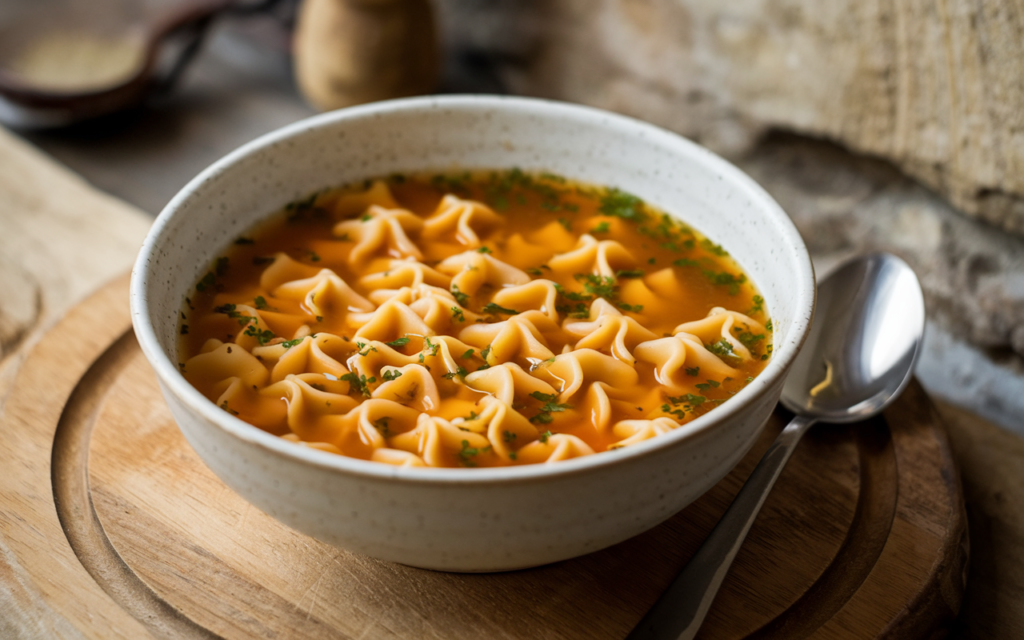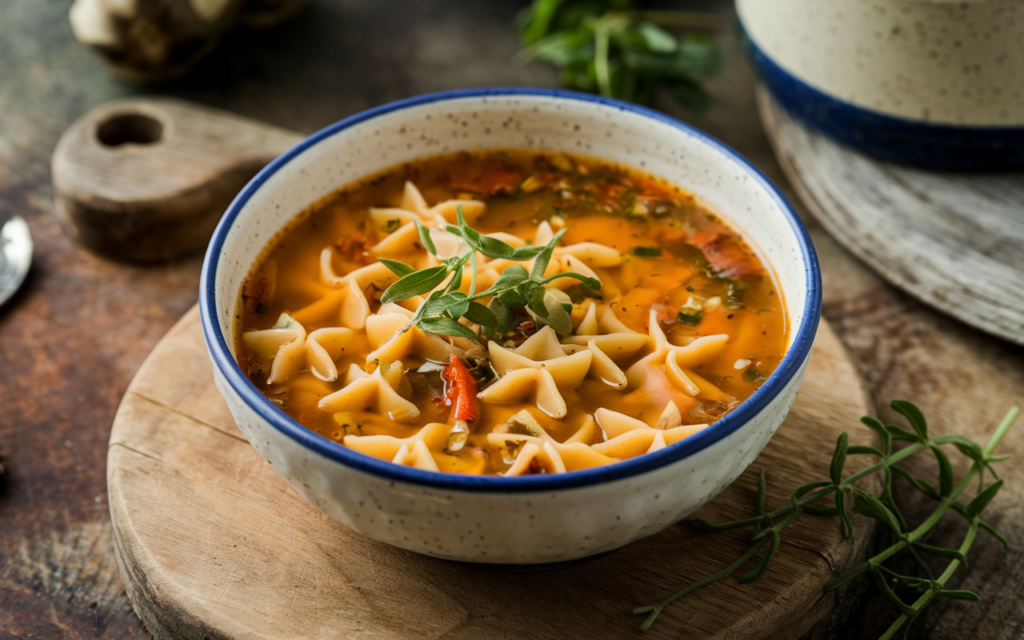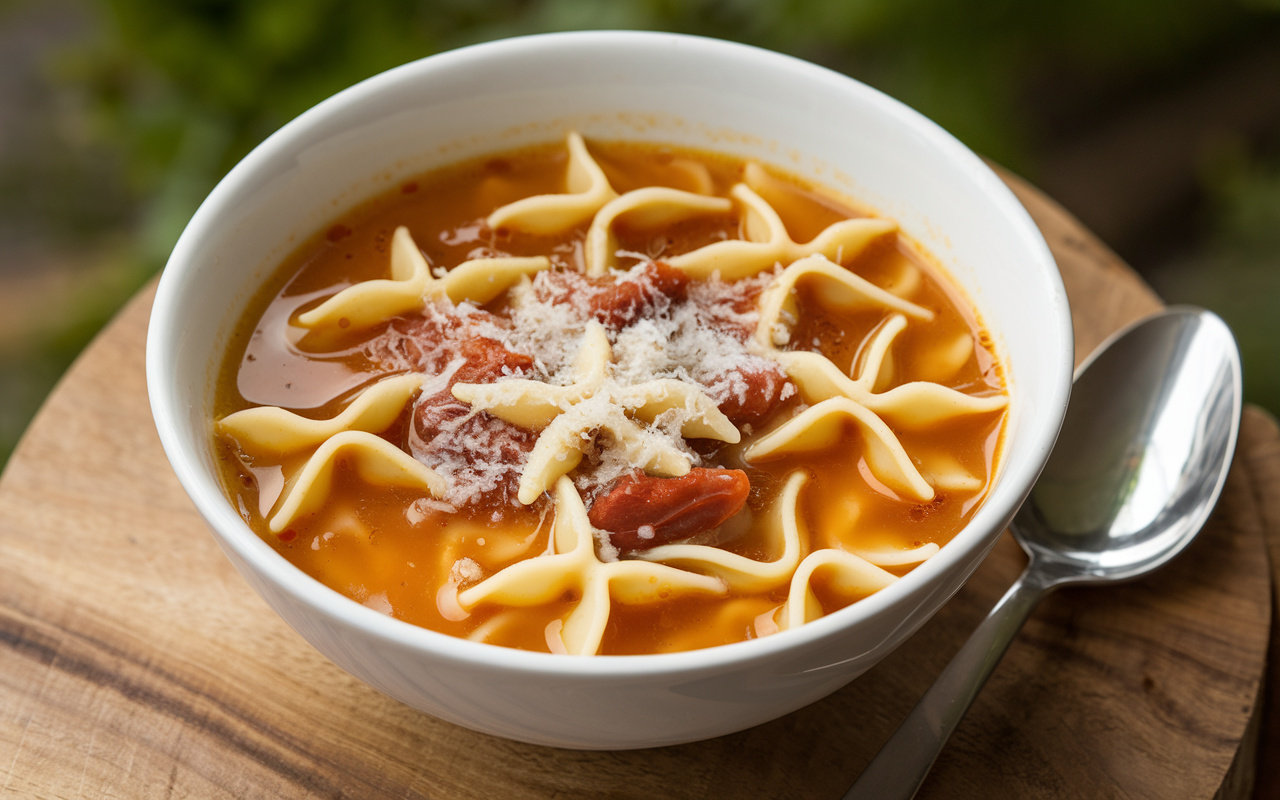Pastina is a tiny type of pasta with a big reputation. Indeed, people love it for its simplicity and versatility. Moreover, it is often associated with comfort and healing, making it a staple in many households. However, is pastina healthy for you? This question undoubtedly holds importance for those who care about their health and diet.
This guide will explore its nutritional profile, cultural significance, and role in a balanced diet. If you’re curious about how to make pastina part of a healthy lifestyle, this article is for you. Additionally, we’ll uncover myths, share recipe ideas, and suggest alternatives for those with special dietary needs.
What is Pastina?
Pastina, which means “little pasta” in Italian, refers to tiny pasta shapes. These are often used in soups or as the base for simple dishes. Star-shaped pastina is the most common, but you can find alphabet shapes or small dots as well.
A Brief History of Pastina
Italian families popularized pastina because it was easy to digest and affordable. Many households made it at home using leftover pasta dough. Over time, it became a symbol of comfort and care, especially for children and the elderly.
Today, chefs and home cooks use pastina to create quick, comforting meals. To learn more, visit our article on The History of Italian Pasta.
Nutritional Profile of Pastina
To answer whether pastina is healthy for you, we need to look at its nutrition. Traditional pastina is made from durum wheat semolina, although whole-grain and gluten-free varieties are also available.
Standard Nutritional Facts (Per 1/2 Cup Cooked)
- Calories: ~110
- Carbohydrates: ~22g
- Protein: ~3g
- Fat: <1g
- Fiber: ~1g
Pastina works best as a base for meals. You can pair it with nutrient-dense ingredients to improve its overall health value.
Is Pastina Healthy for You? Key Considerations
Whether pastina is healthy depends on how you prepare it and what ingredients you add.
Benefits of Pastina
- Easy to Digest
Pastina’s small size and soft texture make it gentle on the stomach. This quality is especially helpful for children or those recovering from illness. - Customizable
By adding vegetables, lean proteins, or healthy fats, you can make pastina more nutritious. - Low in Fat
Traditional pastina contains almost no fat, which suits low-fat diets.
Drawbacks of Pastina
- High Glycemic Index
Refined pasta like pastina can raise blood sugar levels, especially if eaten in large portions. - Low Fiber
Unless you choose whole-grain versions, pastina doesn’t offer much fiber, which supports digestion. - Limited Nutritional Value
On its own, pastina lacks significant vitamins and minerals, but you can easily address this by pairing it with nutrient-rich ingredients.
How to Make Pastina a Healthier Choice
You can improve the health value of pastina with these tips:
Choose Better Varieties
Whole-grain pastina adds more fiber, which helps with digestion and controlling blood sugar. Gluten-free pastina works well for those with sensitivities.
Add More Vegetables
Vegetables like carrots, spinach, or zucchini increase the fiber and vitamin content of your dish. They also make it more colorful and appealing.
Include Protein
Lean proteins, such as chicken, turkey, or beans, turn pastina into a filling and balanced meal.
Use Homemade Broth
Homemade broths contain more nutrients and fewer preservatives than store-bought versions. They also add more depth to your dish.
Explore more ideas in our article on Healthy Soup Recipes.
Cultural Significance of Pastina
In Italian households, pastina symbolizes comfort and care. For instance, families often serve it when someone feels sick or needs extra comfort. As a result, it is affectionately known as “Italian penicillin” and has earned a well-deserved reputation for healing.
Moreover, beyond Italy, other cultures have also adopted pastina and customized it with local ingredients. Because of its simplicity, it has become a global favorite, appealing to diverse tastes and traditions.
Common Ways to Prepare Pastina
Classic Pastina Soup
This traditional dish includes pastina cooked in chicken broth and seasoned with salt, pepper, and parsley. A sprinkle of Parmesan cheese enhances the flavor.
Creamy Cheesy Pastina
Stir in butter, milk, and grated cheese to create a rich and creamy dish.
Protein-Rich Pastina
Add shredded chicken, turkey, or poached eggs for a boost of protein and nutrition.
Vegetable-Loaded Pastina
Mix in diced carrots, peas, or spinach to add vibrant color and essential nutrients.
For more ideas, visit Nutritious Comfort Foods.
Why Does Pastina Make You Feel Better?
Many people associate pastina with feeling better. Its warm broth and soft pasta grains provide comfort. It also helps with hydration and delivers quick energy through its carbohydrates. This combination makes it ideal for recovery.
How Does Pastina Compare to Other Pasta Types?
When it comes to nutrition and versatility, how does pastina stack up against other types of pasta? Let’s explore:
Nutrition Comparison
- Spaghetti vs. Pastina: Spaghetti often has a similar calorie count but contains more fiber when made from whole grains.
- Orzo vs. Pastina: Both are small and used in soups, but pastina cooks faster and is easier to digest.
- Macaroni vs. Pastina: Macaroni has a more distinct texture, making it better for baked dishes, while pastina is ideal for broths and soft preparations.
Cooking Uses
Unlike larger pasta, pastina works well in soups and as a creamy base for quick meals. Its tiny size makes it a favorite for recipes requiring soft textures.

The Role of Pastina in Childhood Nutrition
For parents, pastina is often one of the first solid foods introduced to toddlers. But why is it such a popular choice?
- Soft and Easy to Chew
Pastina’s small size and tender texture are perfect for babies transitioning from purees to solid foods. - Digestible
Its simple ingredients and ease of digestion make it gentle on young stomachs. - Nutritional Customization
Parents can boost its nutritional value by adding pureed vegetables, cheese, or finely chopped proteins.
Is Pastina Gluten-Free?
Traditional pastina is made from durum wheat semolina, making it unsuitable for gluten-free diets. However, gluten-free versions are widely available. These are made from:
- Rice Flour: Offers a similar texture and taste.
- Corn Flour: Adds a slightly sweet flavor.
- Quinoa Flour: Provides a protein boost.
To enjoy gluten-free pastina, look for reputable brands offering certified gluten-free options.
The Rise of Whole-Grain Pastina
Whole-grain pastina has grown in popularity among health-conscious consumers. Here’s why:
- More Fiber
Whole-grain options provide more fiber, supporting digestion and heart health. - Better Blood Sugar Control
Whole grains have a lower glycemic index compared to refined pasta. - Rich Flavor
The nutty taste of whole-grain pastina enhances dishes, especially when paired with savory broths or vegetables.
Creative Ways to Use Pastina
While pastina is most commonly used in soups, there are many creative ways to incorporate it into your meals:
- Breakfast Bowls
Cook pastina in milk and top it with honey, fruit, and nuts for a unique breakfast porridge. - Salads
Toss cooked pastina with olive oil, lemon juice, fresh herbs, and vegetables for a quick pasta salad. - Stuffed Peppers
Use pastina as a stuffing base, mixed with ground meat, cheese, and spices. - Desserts
Sweeten cooked pastina with sugar, vanilla, and cinnamon for an Italian-inspired pudding.
The Emotional Connection to Pastina
Food often evokes strong memories, and pastina is no exception. For many, it reminds them of their childhood or family gatherings. Its association with comfort and care makes it more than just a meal—it becomes a symbol of love and tradition.
- Family Meals: Parents and grandparents often serve pastina to nurture loved ones.
- Healing Food: Many associate it with recovery during times of illness, creating a lasting emotional bond.
How to Store and Reheat Pastina
Proper storage and reheating techniques are essential to maintain the texture and flavor of pastina. Here’s how to do it right:
Storage Tips
- Refrigerate: Place leftover pastina in an airtight container and store it in the refrigerator for up to 3 days.
- Freeze: Freeze cooked pastina in small portions. Thaw overnight in the refrigerator before reheating.
Reheating Tips
- Stovetop: Warm pastina in broth or water over low heat to prevent it from becoming mushy.
- Microwave: Add a splash of water or broth and microwave in short intervals, stirring frequently.
Pastina Around the World
While pastina is deeply rooted in Italian cuisine, similar dishes exist in other cultures:
- Jewish Matzo Ball Soup: A comforting soup made with matzo balls and chicken broth.
- Greek Avgolemono: A lemony chicken soup featuring rice or orzo as the starch base.
- Mexican Sopa de Fideo: A tomato-based noodle soup with fine vermicelli.
These variations highlight the universal appeal of warm, simple, and comforting dishes.
The Science Behind Why Pastina Comforts Us
Food is more than just fuel—it can also impact emotions. The comforting nature of pastina has scientific roots:
- Carbohydrates and Serotonin
The carbohydrates in pastina help the body produce serotonin, a neurotransmitter associated with feelings of well-being and happiness. - Warm Food and Relaxation
Eating warm foods like pastina soup can relax muscles and soothe the digestive system, which reduces stress. - Nostalgia and Memory
Many associate pastina with childhood, evoking positive memories that enhance its comfort factor.
Is Pastina Good for Weight Loss?
If you’re wondering whether pastina fits into a weight-loss plan, the answer depends on portion control and preparation methods. Here’s what to consider:
- Low-Calorie Potential
A small portion of pastina in a broth-based soup is low in calories and can help you feel full. - High Glycemic Index
Refined pastina may cause blood sugar spikes, so choose whole-grain versions for better glycemic control. - Portion Awareness
Overeating any pasta can hinder weight loss. Keep portions small and balance them with vegetables and proteins.
For more tips, explore our Weight-Loss Friendly Recipes.
Environmental Impact of Pastina Production
As more consumers become environmentally conscious, the impact of pasta production comes into focus. Here’s how pastina stacks up:
- Water Usage
Wheat-based products, including pastina, require significant water during cultivation and production. Opt for brands that prioritize sustainable farming. - Carbon Footprint
While pastina has a lower carbon footprint than meat, choosing local or organic products can further reduce environmental impact. - Packaging
Some brands now offer pastina in recyclable or compostable packaging, reducing waste.
How to Make Homemade Pastina
For those who love a DIY approach, making pastina at home is surprisingly easy:
Ingredients
- 2 cups semolina flour
- 1/4 cup water
- A pinch of salt
Instructions
- Combine semolina flour and salt in a bowl. Gradually add water, mixing until a dough forms.
- Roll the dough into thin ropes and cut them into tiny pieces. Shape as desired (e.g., stars or dots).
- Let the pastina dry for an hour before cooking.
Homemade pastina allows you to control ingredients and avoid preservatives found in store-bought versions.
How Pastina Fits into Special Diets
Pastina is versatile enough to adapt to various dietary needs:
- Low-Sodium Diets
Prepare pastina with unsalted broth or water and season lightly with herbs. - Vegan and Vegetarian Diets
Use vegetable broth and add plant-based proteins like tofu or chickpeas. - Keto or Low-Carb Diets
Replace traditional pastina with spiralized zucchini or riced cauliflower to mimic the texture.
Pairing Pastina with Herbs and Spices
While pastina is mild in flavor, it can take on bold profiles with the right seasoning. Here are some ideas:
- Classic Italian
Basil, oregano, and parsley bring out its traditional flavor. - Mediterranean
Add a touch of dill, mint, or lemon zest for a fresh twist. - Spicy Kick
Sprinkle chili flakes or paprika for heat that contrasts beautifully with the soft texture.
The Economics of Pastina: Budget-Friendly Comfort Food
One reason pastina remains popular is its affordability. A single box can stretch across multiple meals, making it an excellent choice for families on a budget. Additionally:
- Minimal Ingredients Required
Most recipes only need broth, pastina, and a few pantry staples. - Reduces Food Waste
Leftover vegetables, proteins, and even sauces can transform a simple bowl of pastina into a gourmet meal.
Seasonal Pastina Recipes
The beauty of pastina lies in its adaptability. Here’s how you can tailor it to the seasons:
- Spring
Add asparagus, peas, and fresh mint for a light and refreshing dish. - Summer
Serve pastina chilled in a pasta salad with tomatoes, cucumbers, and olive oil. - Fall
Incorporate roasted squash, sage, and nutmeg for a warming bowl of comfort. - Winter
Use a rich chicken broth, kale, and a splash of cream for a hearty meal.
The Psychology of Comfort Foods
Why do we turn to dishes like pastina during stressful times? Here are some psychological insights:
- Emotional Regulation
Comfort foods can trigger the release of dopamine, a chemical linked to pleasure and reward. - Cultural Connection
Foods tied to family traditions, like pastina, reinforce a sense of belonging and security. - Simplicity and Familiarity
Simple dishes like pastina are easy to prepare and remind us of happier, uncomplicated times.

Frequently Asked Questions (FAQs)
How healthy is pastina?
When combined with nutrient-dense ingredients, pastina can be a balanced part of your diet.
Why does pastina make you feel better?
Its warmth, soft texture, and hydration properties provide comfort and relief, especially during illness.
What is so special about pastina?
Its versatility, ease of preparation, and cultural significance make it a beloved comfort food.
Why was pastina taken off the market?
Some brands stopped making pastina due to production challenges, but other options are still available.
Exploring Alternatives to Pastina
If you need alternatives, consider these options:
- Gluten-Free Pastina
Look for versions made from rice, corn, or quinoa. - Low-Carb Options
Try spiralized zucchini, cauliflower rice, or shirataki noodles for a lower-carb alternative. - Whole-Grain Choices
Whole-grain pasta provides more fiber and a nuttier flavor.
Read more about alternatives in our article on Pasta Alternatives for Every Diet.
Conclusion
Pastina remains a cherished comfort food with a unique place in many cultures. Although it isn’t a nutritional powerhouse on its own, you can easily turn it into a healthy meal by pairing it with vegetables, lean proteins, and wholesome broths.
Whether you’re seeking comfort, cooking for loved ones, or simply enjoying a nostalgic dish, pastina fits the bill. By choosing better ingredients and mindful preparation, you can enjoy this timeless favorite while staying healthy.

